ABS CHEVROLET MONTE CARLO 2007 6.G Owners Manual
[x] Cancel search | Manufacturer: CHEVROLET, Model Year: 2007, Model line: MONTE CARLO, Model: CHEVROLET MONTE CARLO 2007 6.GPages: 456, PDF Size: 2.43 MB
Page 245 of 456
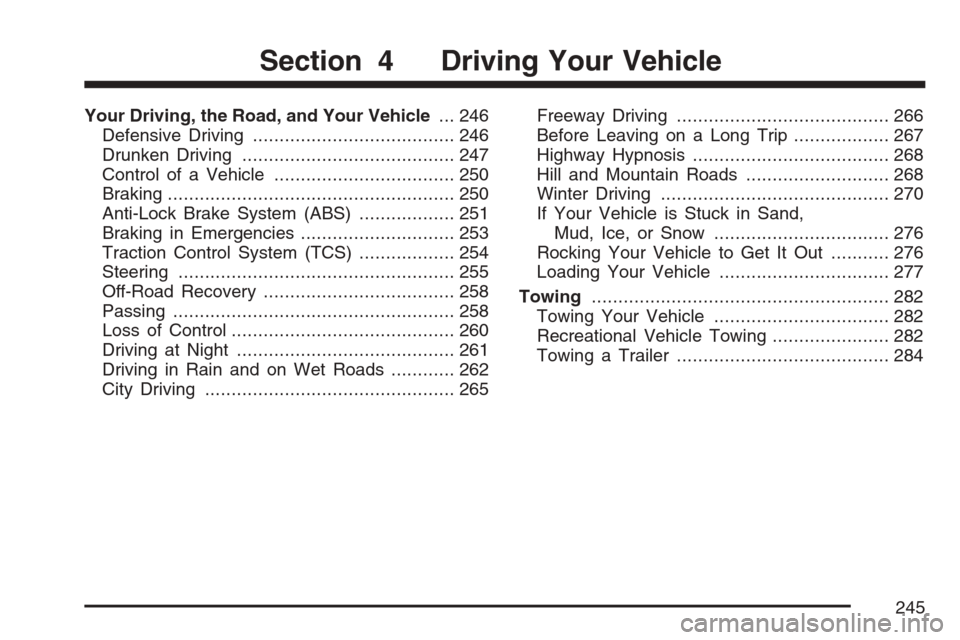
Your Driving, the Road, and Your Vehicle... 246
Defensive Driving...................................... 246
Drunken Driving........................................ 247
Control of a Vehicle.................................. 250
Braking...................................................... 250
Anti-Lock Brake System (ABS).................. 251
Braking in Emergencies............................. 253
Traction Control System (TCS).................. 254
Steering.................................................... 255
Off-Road Recovery.................................... 258
Passing..................................................... 258
Loss of Control.......................................... 260
Driving at Night......................................... 261
Driving in Rain and on Wet Roads............ 262
City Driving............................................... 265Freeway Driving........................................ 266
Before Leaving on a Long Trip.................. 267
Highway Hypnosis..................................... 268
Hill and Mountain Roads........................... 268
Winter Driving........................................... 270
If Your Vehicle is Stuck in Sand,
Mud, Ice, or Snow ................................. 276
Rocking Your Vehicle to Get It Out........... 276
Loading Your Vehicle................................ 277
Towing........................................................ 282
Towing Your Vehicle ................................. 282
Recreational Vehicle Towing...................... 282
Towing a Trailer........................................ 284
Section 4 Driving Your Vehicle
245
Page 251 of 456
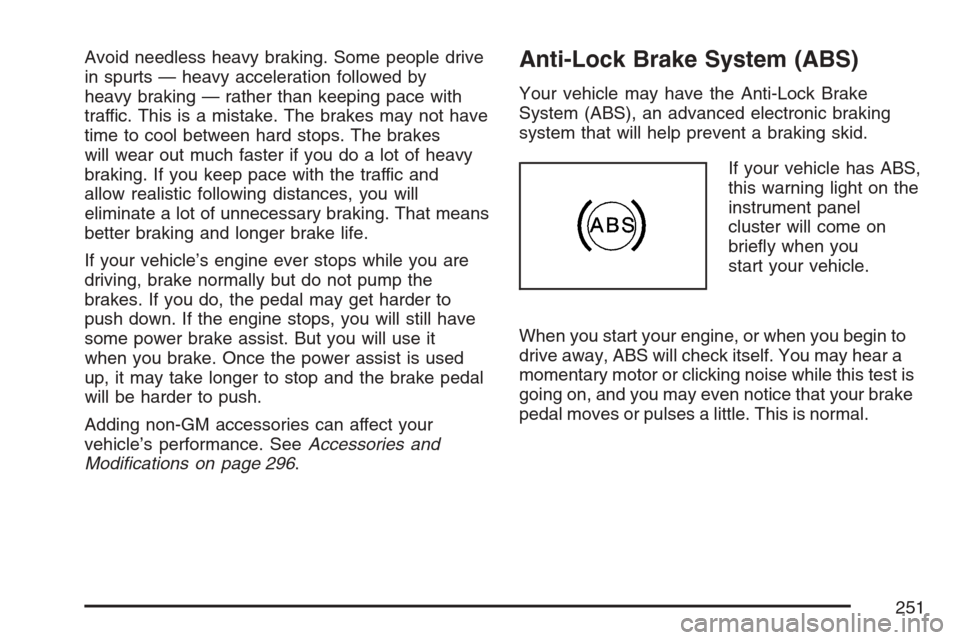
Avoid needless heavy braking. Some people drive
in spurts — heavy acceleration followed by
heavy braking — rather than keeping pace with
traffic. This is a mistake. The brakes may not have
time to cool between hard stops. The brakes
will wear out much faster if you do a lot of heavy
braking. If you keep pace with the traffic and
allow realistic following distances, you will
eliminate a lot of unnecessary braking. That means
better braking and longer brake life.
If your vehicle’s engine ever stops while you are
driving, brake normally but do not pump the
brakes. If you do, the pedal may get harder to
push down. If the engine stops, you will still have
some power brake assist. But you will use it
when you brake. Once the power assist is used
up, it may take longer to stop and the brake pedal
will be harder to push.
Adding non-GM accessories can affect your
vehicle’s performance. SeeAccessories and
Modi�cations on page 296.Anti-Lock Brake System (ABS)
Your vehicle may have the Anti-Lock Brake
System (ABS), an advanced electronic braking
system that will help prevent a braking skid.
If your vehicle has ABS,
this warning light on the
instrument panel
cluster will come on
brie�y when you
start your vehicle.
When you start your engine, or when you begin to
drive away, ABS will check itself. You may hear a
momentary motor or clicking noise while this test is
going on, and you may even notice that your brake
pedal moves or pulses a little. This is normal.
251
Page 252 of 456
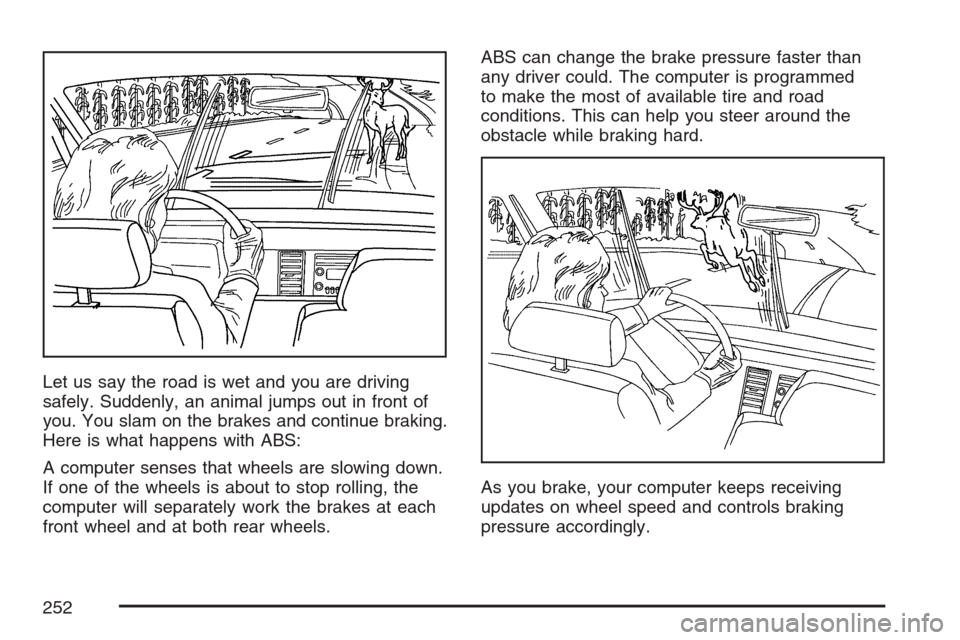
Let us say the road is wet and you are driving
safely. Suddenly, an animal jumps out in front of
you. You slam on the brakes and continue braking.
Here is what happens with ABS:
A computer senses that wheels are slowing down.
If one of the wheels is about to stop rolling, the
computer will separately work the brakes at each
front wheel and at both rear wheels.ABS can change the brake pressure faster than
any driver could. The computer is programmed
to make the most of available tire and road
conditions. This can help you steer around the
obstacle while braking hard.
As you brake, your computer keeps receiving
updates on wheel speed and controls braking
pressure accordingly.
252
Page 253 of 456
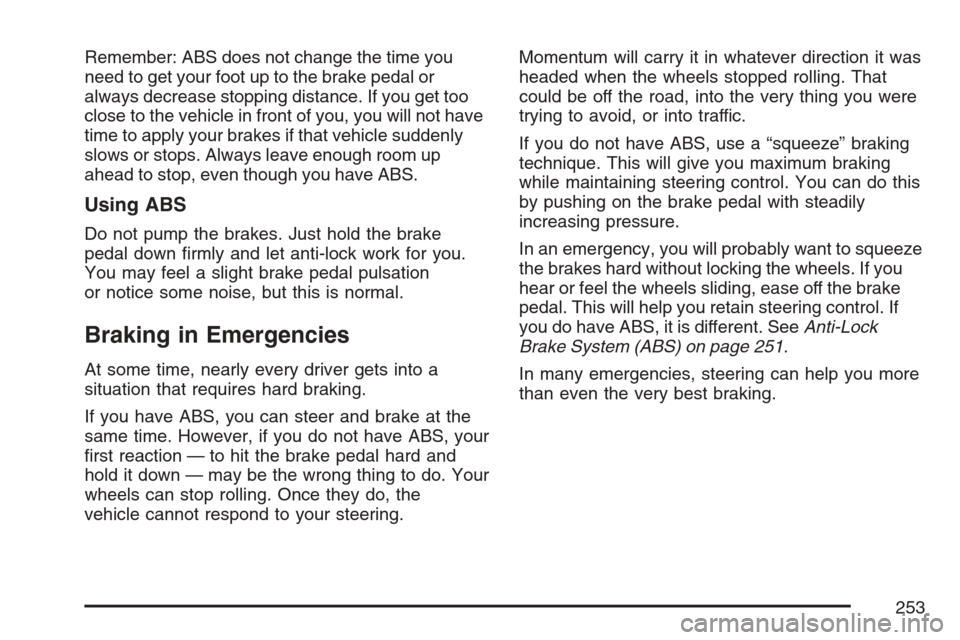
Remember: ABS does not change the time you
need to get your foot up to the brake pedal or
always decrease stopping distance. If you get too
close to the vehicle in front of you, you will not have
time to apply your brakes if that vehicle suddenly
slows or stops. Always leave enough room up
ahead to stop, even though you have ABS.
Using ABS
Do not pump the brakes. Just hold the brake
pedal down �rmly and let anti-lock work for you.
You may feel a slight brake pedal pulsation
or notice some noise, but this is normal.
Braking in Emergencies
At some time, nearly every driver gets into a
situation that requires hard braking.
If you have ABS, you can steer and brake at the
same time. However, if you do not have ABS, your
�rst reaction — to hit the brake pedal hard and
hold it down — may be the wrong thing to do. Your
wheels can stop rolling. Once they do, the
vehicle cannot respond to your steering.Momentum will carry it in whatever direction it was
headed when the wheels stopped rolling. That
could be off the road, into the very thing you were
trying to avoid, or into traffic.
If you do not have ABS, use a “squeeze” braking
technique. This will give you maximum braking
while maintaining steering control. You can do this
by pushing on the brake pedal with steadily
increasing pressure.
In an emergency, you will probably want to squeeze
the brakes hard without locking the wheels. If you
hear or feel the wheels sliding, ease off the brake
pedal. This will help you retain steering control. If
you do have ABS, it is different. SeeAnti-Lock
Brake System (ABS) on page 251.
In many emergencies, steering can help you more
than even the very best braking.
253
Page 261 of 456
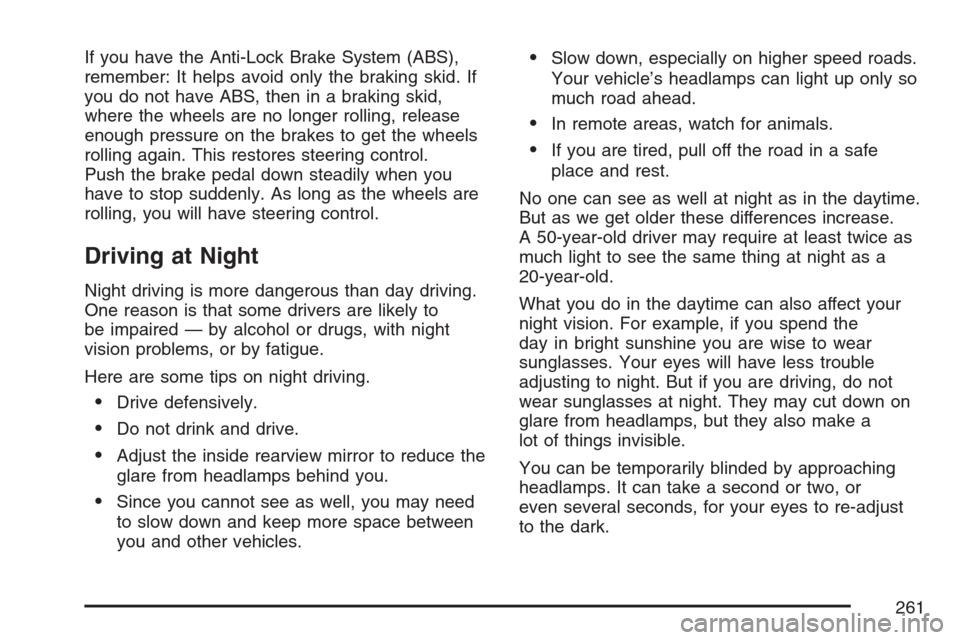
If you have the Anti-Lock Brake System (ABS),
remember: It helps avoid only the braking skid. If
you do not have ABS, then in a braking skid,
where the wheels are no longer rolling, release
enough pressure on the brakes to get the wheels
rolling again. This restores steering control.
Push the brake pedal down steadily when you
have to stop suddenly. As long as the wheels are
rolling, you will have steering control.
Driving at Night
Night driving is more dangerous than day driving.
One reason is that some drivers are likely to
be impaired — by alcohol or drugs, with night
vision problems, or by fatigue.
Here are some tips on night driving.
Drive defensively.
Do not drink and drive.
Adjust the inside rearview mirror to reduce the
glare from headlamps behind you.
Since you cannot see as well, you may need
to slow down and keep more space between
you and other vehicles.
Slow down, especially on higher speed roads.
Your vehicle’s headlamps can light up only so
much road ahead.
In remote areas, watch for animals.
If you are tired, pull off the road in a safe
place and rest.
No one can see as well at night as in the daytime.
But as we get older these differences increase.
A 50-year-old driver may require at least twice as
much light to see the same thing at night as a
20-year-old.
What you do in the daytime can also affect your
night vision. For example, if you spend the
day in bright sunshine you are wise to wear
sunglasses. Your eyes will have less trouble
adjusting to night. But if you are driving, do not
wear sunglasses at night. They may cut down on
glare from headlamps, but they also make a
lot of things invisible.
You can be temporarily blinded by approaching
headlamps. It can take a second or two, or
even several seconds, for your eyes to re-adjust
to the dark.
261
Page 273 of 456
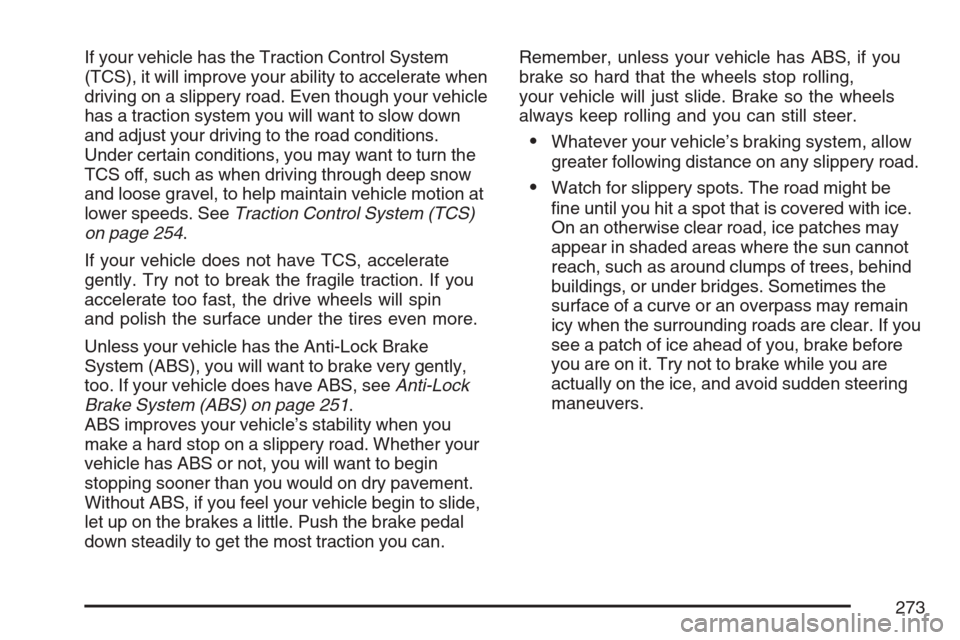
If your vehicle has the Traction Control System
(TCS), it will improve your ability to accelerate when
driving on a slippery road. Even though your vehicle
has a traction system you will want to slow down
and adjust your driving to the road conditions.
Under certain conditions, you may want to turn the
TCS off, such as when driving through deep snow
and loose gravel, to help maintain vehicle motion at
lower speeds. SeeTraction Control System (TCS)
on page 254.
If your vehicle does not have TCS, accelerate
gently. Try not to break the fragile traction. If you
accelerate too fast, the drive wheels will spin
and polish the surface under the tires even more.
Unless your vehicle has the Anti-Lock Brake
System (ABS), you will want to brake very gently,
too. If your vehicle does have ABS, seeAnti-Lock
Brake System (ABS) on page 251.
ABS improves your vehicle’s stability when you
make a hard stop on a slippery road. Whether your
vehicle has ABS or not, you will want to begin
stopping sooner than you would on dry pavement.
Without ABS, if you feel your vehicle begin to slide,
let up on the brakes a little. Push the brake pedal
down steadily to get the most traction you can.Remember, unless your vehicle has ABS, if you
brake so hard that the wheels stop rolling,
your vehicle will just slide. Brake so the wheels
always keep rolling and you can still steer.
Whatever your vehicle’s braking system, allow
greater following distance on any slippery road.
Watch for slippery spots. The road might be
�ne until you hit a spot that is covered with ice.
On an otherwise clear road, ice patches may
appear in shaded areas where the sun cannot
reach, such as around clumps of trees, behind
buildings, or under bridges. Sometimes the
surface of a curve or an overpass may remain
icy when the surrounding roads are clear. If you
see a patch of ice ahead of you, brake before
you are on it. Try not to brake while you are
actually on the ice, and avoid sudden steering
maneuvers.
273
Page 290 of 456
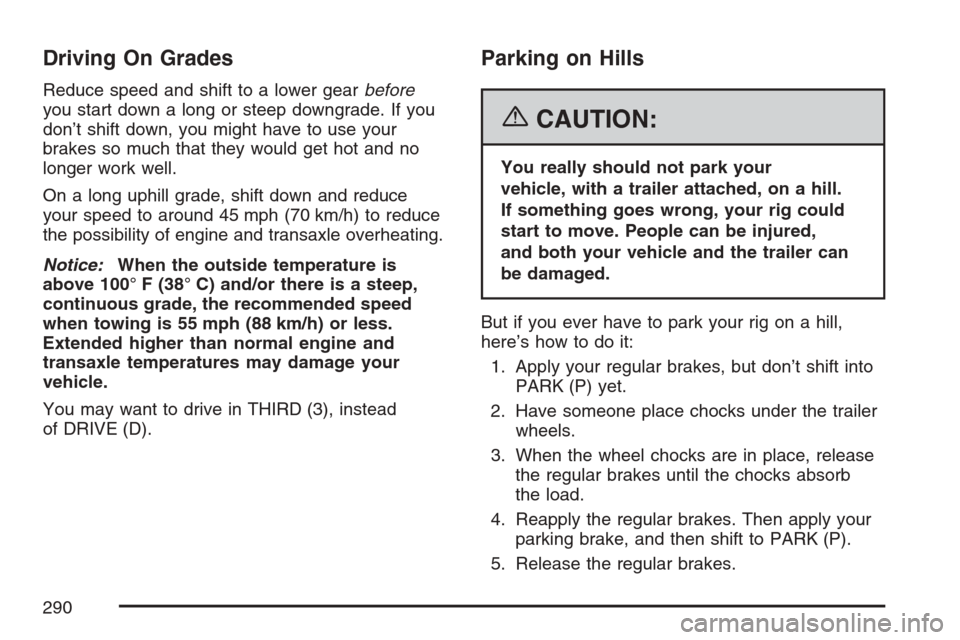
Driving On Grades
Reduce speed and shift to a lower gearbefore
you start down a long or steep downgrade. If you
don’t shift down, you might have to use your
brakes so much that they would get hot and no
longer work well.
On a long uphill grade, shift down and reduce
your speed to around 45 mph (70 km/h) to reduce
the possibility of engine and transaxle overheating.
Notice:When the outside temperature is
above 100° F (38° C) and/or there is a steep,
continuous grade, the recommended speed
when towing is 55 mph (88 km/h) or less.
Extended higher than normal engine and
transaxle temperatures may damage your
vehicle.
You may want to drive in THIRD (3), instead
of DRIVE (D).
Parking on Hills
{CAUTION:
You really should not park your
vehicle, with a trailer attached, on a hill.
If something goes wrong, your rig could
start to move. People can be injured,
and both your vehicle and the trailer can
be damaged.
But if you ever have to park your rig on a hill,
here’s how to do it:
1. Apply your regular brakes, but don’t shift into
PARK (P) yet.
2. Have someone place chocks under the trailer
wheels.
3. When the wheel chocks are in place, release
the regular brakes until the chocks absorb
the load.
4. Reapply the regular brakes. Then apply your
parking brake, and then shift to PARK (P).
5. Release the regular brakes.
290
Page 316 of 456
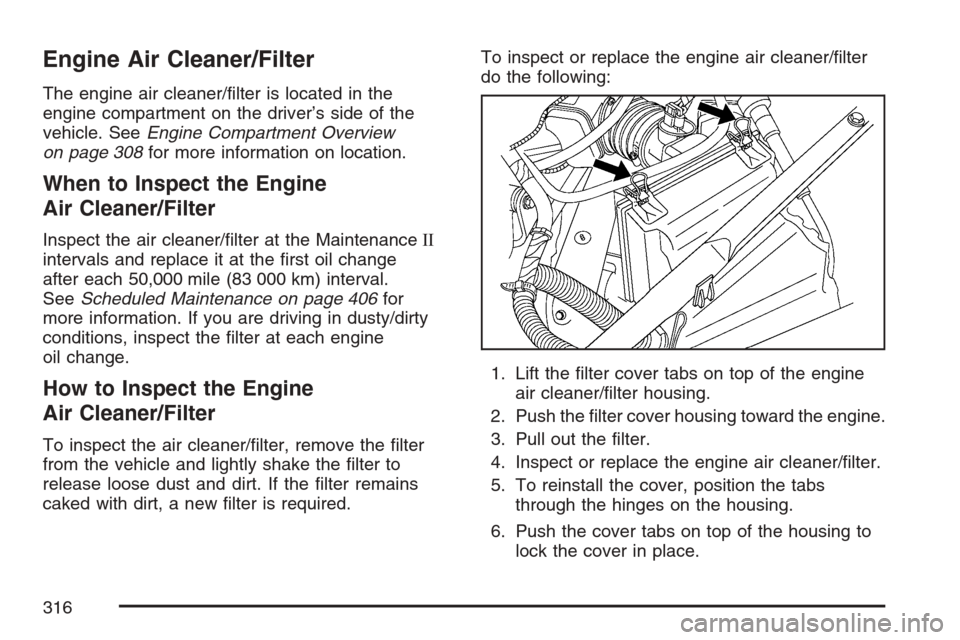
Engine Air Cleaner/Filter
The engine air cleaner/�lter is located in the
engine compartment on the driver’s side of the
vehicle. SeeEngine Compartment Overview
on page 308for more information on location.
When to Inspect the Engine
Air Cleaner/Filter
Inspect the air cleaner/�lter at the MaintenanceII
intervals and replace it at the �rst oil change
after each 50,000 mile (83 000 km) interval.
SeeScheduled Maintenance on page 406for
more information. If you are driving in dusty/dirty
conditions, inspect the �lter at each engine
oil change.
How to Inspect the Engine
Air Cleaner/Filter
To inspect the air cleaner/�lter, remove the �lter
from the vehicle and lightly shake the �lter to
release loose dust and dirt. If the �lter remains
caked with dirt, a new �lter is required.To inspect or replace the engine air cleaner/�lter
do the following:
1. Lift the �lter cover tabs on top of the engine
air cleaner/�lter housing.
2. Push the �lter cover housing toward the engine.
3. Pull out the �lter.
4. Inspect or replace the engine air cleaner/�lter.
5. To reinstall the cover, position the tabs
through the hinges on the housing.
6. Push the cover tabs on top of the housing to
lock the cover in place.
316
Page 386 of 456
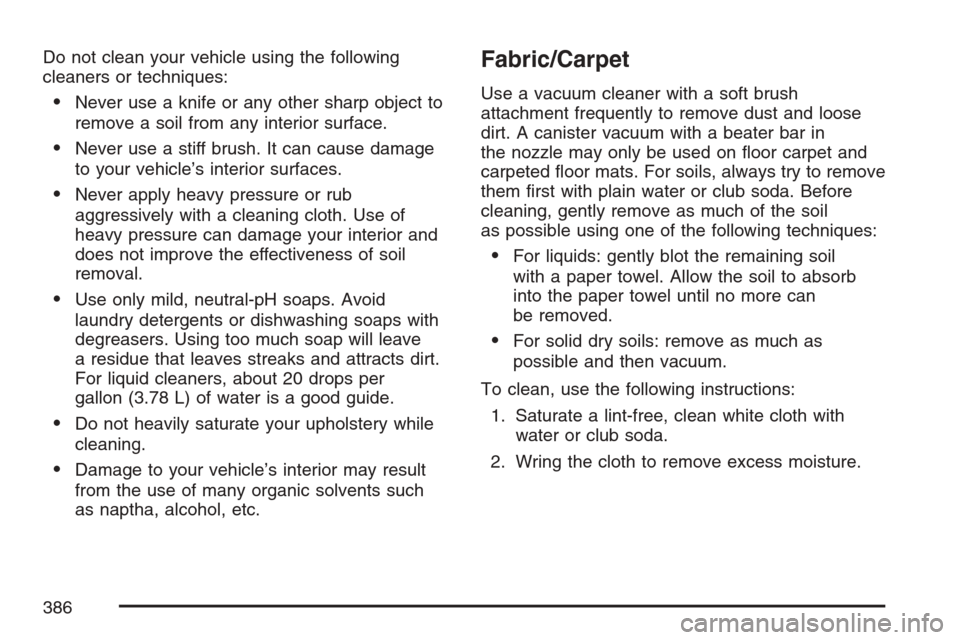
Do not clean your vehicle using the following
cleaners or techniques:
Never use a knife or any other sharp object to
remove a soil from any interior surface.
Never use a stiff brush. It can cause damage
to your vehicle’s interior surfaces.
Never apply heavy pressure or rub
aggressively with a cleaning cloth. Use of
heavy pressure can damage your interior and
does not improve the effectiveness of soil
removal.
Use only mild, neutral-pH soaps. Avoid
laundry detergents or dishwashing soaps with
degreasers. Using too much soap will leave
a residue that leaves streaks and attracts dirt.
For liquid cleaners, about 20 drops per
gallon (3.78 L) of water is a good guide.
Do not heavily saturate your upholstery while
cleaning.
Damage to your vehicle’s interior may result
from the use of many organic solvents such
as naptha, alcohol, etc.
Fabric/Carpet
Use a vacuum cleaner with a soft brush
attachment frequently to remove dust and loose
dirt. A canister vacuum with a beater bar in
the nozzle may only be used on �oor carpet and
carpeted �oor mats. For soils, always try to remove
them �rst with plain water or club soda. Before
cleaning, gently remove as much of the soil
as possible using one of the following techniques:
For liquids: gently blot the remaining soil
with a paper towel. Allow the soil to absorb
into the paper towel until no more can
be removed.
For solid dry soils: remove as much as
possible and then vacuum.
To clean, use the following instructions:
1. Saturate a lint-free, clean white cloth with
water or club soda.
2. Wring the cloth to remove excess moisture.
386
Page 398 of 456
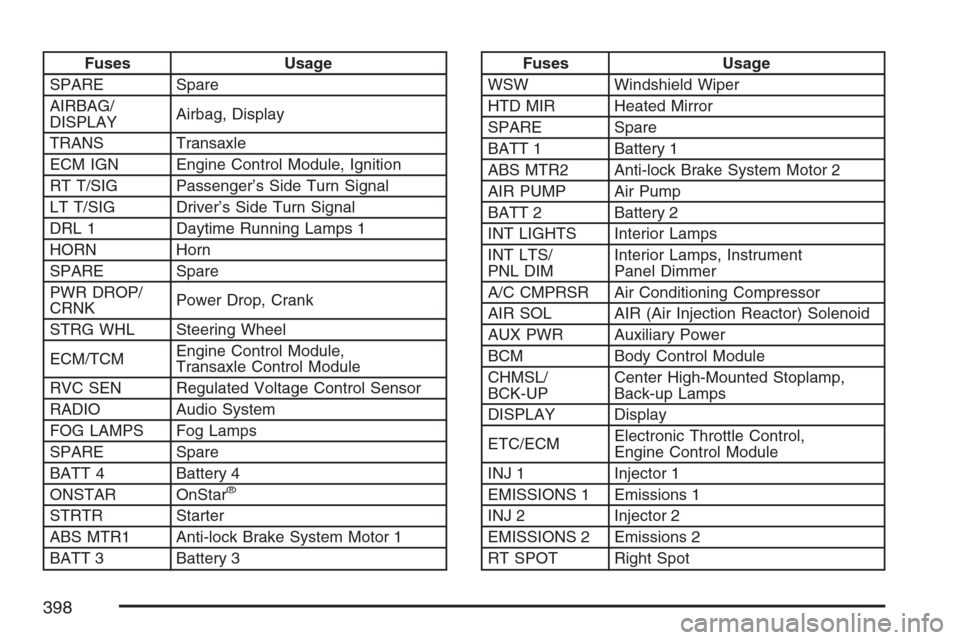
Fuses Usage
SPARE Spare
AIRBAG/
DISPLAYAirbag, Display
TRANS Transaxle
ECM IGN Engine Control Module, Ignition
RT T/SIG Passenger’s Side Turn Signal
LT T/SIG Driver’s Side Turn Signal
DRL 1 Daytime Running Lamps 1
HORN Horn
SPARE Spare
PWR DROP/
CRNKPower Drop, Crank
STRG WHL Steering Wheel
ECM/TCMEngine Control Module,
Transaxle Control Module
RVC SEN Regulated Voltage Control Sensor
RADIO Audio System
FOG LAMPS Fog Lamps
SPARE Spare
BATT 4 Battery 4
ONSTAR OnStar
®
STRTR Starter
ABS MTR1 Anti-lock Brake System Motor 1
BATT 3 Battery 3
Fuses Usage
WSW Windshield Wiper
HTD MIR Heated Mirror
SPARE Spare
BATT 1 Battery 1
ABS MTR2 Anti-lock Brake System Motor 2
AIR PUMP Air Pump
BATT 2 Battery 2
INT LIGHTS Interior Lamps
INT LTS/
PNL DIMInterior Lamps, Instrument
Panel Dimmer
A/C CMPRSR Air Conditioning Compressor
AIR SOL AIR (Air Injection Reactor) Solenoid
AUX PWR Auxiliary Power
BCM Body Control Module
CHMSL/
BCK-UPCenter High-Mounted Stoplamp,
Back-up Lamps
DISPLAY Display
ETC/ECMElectronic Throttle Control,
Engine Control Module
INJ 1 Injector 1
EMISSIONS 1 Emissions 1
INJ 2 Injector 2
EMISSIONS 2 Emissions 2
RT SPOT Right Spot
398